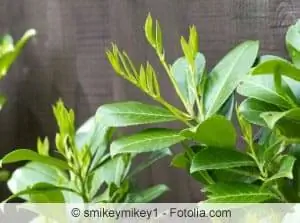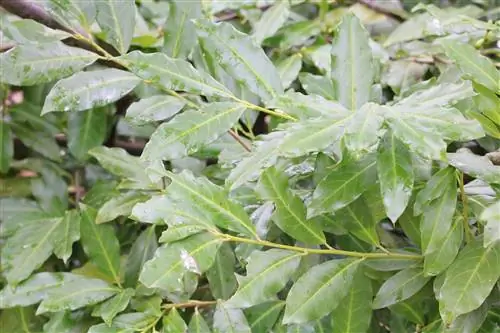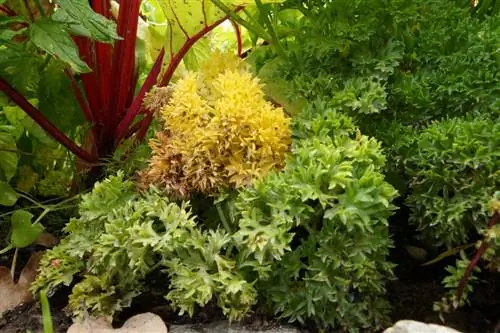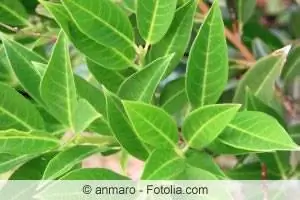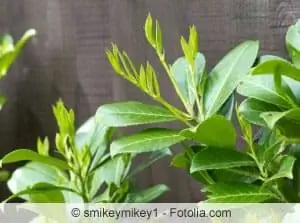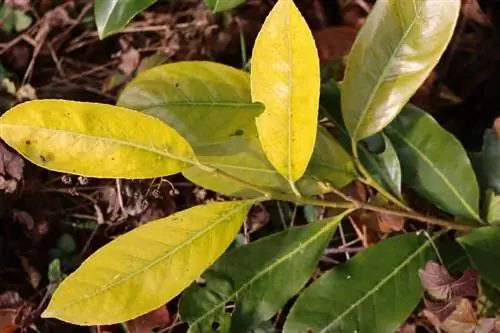- Author admin [email protected].
- Public 2023-12-17 03:39.
- Last modified 2025-06-01 06:48.
The laurel cherry, which is generally considered robust and undemanding, can also cause problems. Yellow-colored leaves are often found on cherry laurel, which quickly affects the entire plant. Finding the reason for this is difficult because many factors can have a negative effect on leaf color. However, in order to promote the he alth and resilience of your evergreen plants, research into the causes is almost essential. Incidentally, it is a mistake to assume that only freshly planted or young cherry laurel plants are susceptible to such deficiency symptoms.
The right location
Every plant has certain requirements for soil and lighting conditions. Cherry laurel is primarily one of the undemanding plants and can often cope with adverse site conditions. But even the robust evergreens have little to counteract toxins in the soil or planting in a windbreak. In this case, yellow leaves and often stunted growth are the result. If you repeatedly have difficulties and problems with your plants in one location, you should have a professional soil analysis carried out. This is associated with costs, but is much more effective than randomly tinkering with the substrate yourself.
Prunus laurocerasus, the Latin name for the laurel cherry, requires humus-rich, deep soil. The substrate must not be too acidic. Regular mulching and fertilizing are among the basic care measures. The plant species from the rose family is particularly used as an evergreen privacy screen in the garden. However, young cherry laurels in particular are extremely susceptible to wind and cold. However, when planting, you can use a tried and tested trick that makes rooting easier for the young plants: sprinkle a few handfuls of half-ripe compost directly in the planting hole. The slow decomposition of the material supplies the still sensitive roots of the evergreen plants with heat. Avoid a location in full sun and give Prunus a bright, partially shaded spot in your own garden.
Frost Damage
Evergreen plants - as the name suggests - retain their dense, dark green foliage even in winter. The plants bring color to the otherwise dreary landscape and offer birds and other animals a protective refuge. Cherry laurel is also one of the hardy plants. But the resilience of these plants also has its limits. Some varieties of laurel cherry can only survive the cold season unscathed in regions with mild winters. Before you buy, you should therefore find out more about the requirements of the respective Prunus species.
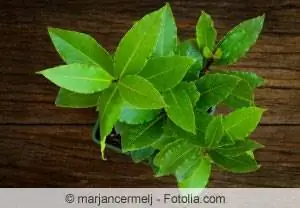
Cherry laurel is preferably planted in late summer. Depending on the weather, early cold snaps can also cause considerable damage to particularly robust varieties. Yellowed leaves are sometimes the first signs of frost damage. You can prevent this by following these tips:
- In addition to the compost in the planting hole, sprinkle a warming layer of bark mulch.
- Protect young or freshly planted plants with burlap.
- Select hardy varieties.
- Only buy he althy plants.
If you plant the evergreen plants as a decorative and opaque privacy hedge, pay attention to a certain minimum distance. The roots must fully develop and develop so that they can optimally supply the plant and effectively protect it from frost. By the way, don't despair if the leaves of your evergreen plant change color despite all the precautionary measures. Because in long-term sub-zero temperatures, the soil freezes completely and the plant is no longer able to absorb vital moisture. Frost and sun contribute to the leaves wilting. However, he althy Prunus species are able to compensate for this damage in spring.
Proper supply of water
The robustness and resilience of cherry laurel quickly reaches its limits when it comes to watering. Even the root system of older plants reacts sensitively as soon as it is permanently exposed to standing moisture. Even before ascomycetes attack the laurel cherries and cause root rot, it is the leaves that turn pale yellow. You can avoid waterlogging of potted plants by creating a drainage system made of pottery shards or lava grit at the bottom of the container. You can create something similar in the garden. To do this, mix the excavated soil with fine pebbles. These counteract compaction of the soil and ensure that irrigation and rain water can drain away more easily.
Just like waterlogging, long-term drought also has a negative effect on ornamental plants. The root ball of the plants must not dry out completely. Winter is a critical time of year for cherry laurel. Many gardeners simply forget that evergreen plants also need to be watered in winter. If the plants do not survive the winter months, they are usually not frozen, but simply dried out. Therefore, react immediately if the leaves of the cherry laurel change color in autumn or winter. Only water with lukewarm water on frost-free days. The laurel cherry reacts sensitively to a high lime content. For this reason, not only should the location be chosen as lime-free as possible, but the irrigation water should also not contain any lime.
Nutrition problems
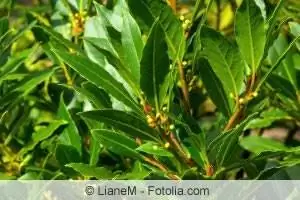
Have you chosen the right location and are watering regularly, but your cherry laurel still has yellow leaves? Like all plants, the evergreen ornamental shrub does not only depend on the right location and a regular supply of water. The laurel cherry also relies on fertilizer. How this is administered depends on the location and the consistency of the soil. In freshly prepared soil, it is sufficient to mix a generous layer of compost into the substrate in spring and autumn. In addition, you can enrich the soil with coffee grounds or horn shavings in summer. In poor soil, the plants need support in the form of liquid or long-term fertilizer. A lack of nutrients and minerals is not immediately noticeable in the growth habit. At first the vitality suffers, the foliage of the cherry laurel takes on a yellow color.
On the other hand, exactly the opposite can be the case. No matter what type of fertilizer you apply, the principle always applies: less is more. Just like standing moisture, the plants cannot process excessive nutrients. The root system literally “burns” and is no longer able to absorb enough water. As soon as you recognize the signs, quick help is recommended. You can quickly boost under-supplied plants with fertilizer. If there is an oversupply, however, it is advisable to remove the substrate generously and replace it with lean soil. In winter, all fertilizers are relegated to the farthest corner of the garden shed or garage. If yellow leaves appear on cherry laurel in the cold season, there is usually another reason.
Diseases
The disease chlorosis is often found on cherry laurel. This is not caused by pests or fungal pathogens, but is purely due to a chlorophyll deficiency. The green veins on the otherwise yellow leaves are typical of chlorosis. Possible causes of the disease can be:
- Poisoning by herbicides.
- Excessive watering with hard water.
- High lime content of the substrate.
- Sharp temperature fluctuations.
- Lack of iron, nitrogen, magnesium, potassium or calcium.
Chlorosis can permanently weaken plants. If yellow-colored leaves repeatedly appear on the laurel cherry despite proper care, you should remove a large area of soil around the plant. Replace it with humus-rich, slightly sandy substrate.
Conclusion
This shows that evergreen plants are by no means indestructible. Like all other plants in the garden and on the windowsill, the laurel cherry also depends on proper care and the optimal location. Yellow leaves on cherry laurel should not be taken lightly. There is almost always a deficiency behind it, which can quickly develop into a threatening illness.

